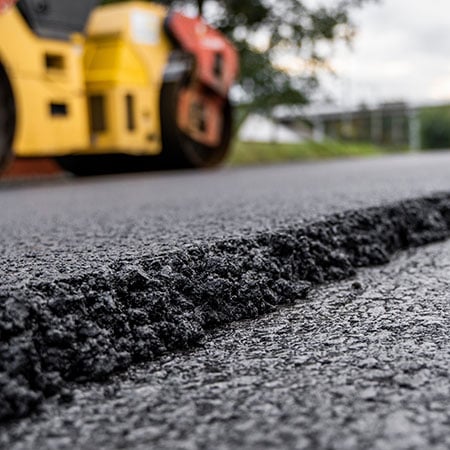Asphalt
X-ray analyses to ensure durability of materials
The durability and performance of asphalt pavements depend largely on the quality and composition of the raw materials used and the formulation of the asphalt mixture. A thorough understanding of the chemical and mineralogical properties of these materials is essential for the development of resilient, standard-compliant road construction materials, especially with regard to climatic stress, traffic loads and ageing mechanisms.
Modern X-ray analysis techniques such as X-ray fluorescence analysis (XRF) and X-ray diffraction (XRD) provide indispensable information for this purpose. XRF enables fast and precise elemental analysis of aggregates, fillers and asphalts, while XRD allows detailed phase analysis of the mineral components. This makes it possible to reliably determine both the chemical composition and the crystalline structure of aggregates and additives.
These analytical methods are crucial for controlling raw material quality, evaluating potential interactions in the mixture and ensuring mechanical properties such as strength, deformation resistance and weather resistance. The targeted use of XRF and XRD analyses ensures consistent material quality and significantly improves the long-term performance of asphalt pavements.

Analytics along the raw material chain
From mineral raw materials to asphalt mix
The quality and durability of asphalt pavements depend to a large extent on the mineral raw materials used. These make up the main component of the mix, accounting for up to 95% of its mass. They include natural aggregates such as basalt, diabase, limestone or granite, as well as fine-grained fillers and additives such as limestone powder, cement or fly ash. A precise knowledge of the chemical and mineralogical properties of these materials is essential in order to develop optimum mix designs and ensure long-term performance.
High-resolution X-ray analysis methods are used right from the selection and characterization of the primary and secondary raw materials (e.g. recycled materials).
-
Wavelength dispersive X-ray fluorescence analysis (WDXRF) enables quantitative determination of the elemental composition – in particular of the main oxides such as SiO₂, Al₂O₃, CaO, Fe₂O₃, MgO, TiO₂ and other trace elements. This allows both differences between rock types and critical substance contents (e.g. alkali, sulphur, phosphorus).
-
X-ray diffraction (XRD) provides complementary information about the crystalline phase structure. It identifies typical mineral phases such as quartz, feldspar, calcite, dolomite, mica or clay minerals. This is particularly relevant for assessing moisture absorption, chemical reactivity or frost resistance.
Both methods can also be used to analyze fillers (e.g. rock flour, cement, hydrated lime) and recycled aggregates to check their suitability and compatibility with the asphalt matrix. XRF-based app packs such as Oxide-FB PAK offer a turnkey solution for routine analysis: pre-calibrated with 44 certified reference materials and optimized for oxide compositions.
In the finished asphalt mixture itself, XRF can be used to monitor the total concentration of mineral components, while XRD is used to identify stable or reactive phases. This also allows the homogeneity of the mixture or the influence of additives to be assessed, an important aspect for quality assurance in the mixing plant.
The consistent use of XRF and XRD along the entire raw material chain—from the input material to the end product—enables seamless analytical control. This makes a decisive contribution to ensuring the performance, environmental compatibility and standard compliance of asphalt products.
Recommended products
Not seeing what you are looking for? Try Product Finder.

Contact Us
Whether you're interested in getting a quote, want a demo, need technical support, or simply have a question, we're here to help.

Subscribe to the Bridge newsletter
Stay up to date with materials analysis news and upcoming conferences, webinars and podcasts, as well as learning new analytical techniques and applications.
